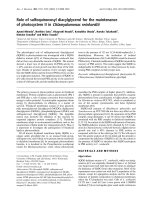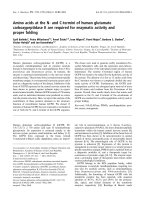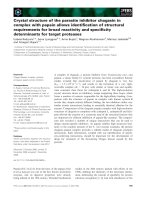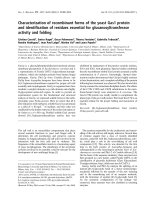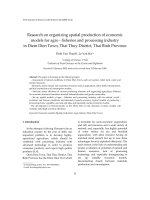IDENTIFICATION OF NOVEL SMALL MOLECULE INHIBITORS OF PROTEINS REQUIRED FOR GENOMIC MAINTENANCE AND STABILITY
Bạn đang xem bản rút gọn của tài liệu. Xem và tải ngay bản đầy đủ của tài liệu tại đây (3.05 MB, 147 trang )
IDENTIFICATION OF NOVEL SMALL MOLECULE INHIBITORS OF
PROTEINS REQUIRED FOR GENOMIC MAINTENANCE AND
STABILITY
Sarah C. Shuck
Submitted to the faculty of the University Graduate School
in partial fulfillment of the requirements
for the degree
Doctor of Philosophy
in the Department of Biochemistry and Molecular Biology,
Indiana University
June 2010
ii
Accepted by the Faculty of Indiana University, in partial
fulfillment of the requirements for the degree of Doctor of Philosophy.
John J. Turchi, Ph.D., Chair
Mark R. Kelley, Ph.D.
Doctoral Committee
Thomas D. Hurley, Ph.D.
April 16, 2010
Frank A. Witzmann, Ph.D.
iii
ACKNOWLEDGEMENTS
Foremost I would like to thank my thesis advisor Dr. John Turchi for his
assistance, support and advice. He has gone above and beyond to provide me with
wonderful advice, both professionally and scientifically. He has also been an amazing
person to work for and with throughout my time here. I would also like to thank the
other members of my committee, Dr. Mark Kelley, Dr. Tom Hurley and Dr. Frank
Witzmann for their advice and help in earning my Ph.D. The members of the Turchi lab,
especially Katie Pawelczak, have been a tremendous source of help, advice and
friendship over the years. I would also like to specifically thank Brooke Andrews, Emily
Short, John Montgomery and Victor Anciano for working closely with me on my project
and really helping to keep it moving forward. I would also like to thank my family for
supporting me throughout all of my higher education, it has been a very long road! My
dad has given me so much wonderful advice about both work and life and his words will
always stick with me. My mother has been a great friend and ear over the years. I would
especially like to thank my brother and sister, Josh and Jodi, for all of their love and
support throughout the years.
iv
ABSTRACT
Sarah C. Shuck
Targeting uncontrolled cell proliferation and resistance to DNA damaging
chemotherapeutics using small molecule inhibitors of proteins involved in these pathways
has significant potential in cancer treatment. Several proteins involved in genomic
maintenance and stability have been implicated both in the development of cancer and
the response to chemotherapeutic treatment. Replication Protein A, RPA, the eukaryotic
single-strand DNA binding protein, is essential for genomic maintenance and stability via
roles in both DNA replication and repair. Xeroderma Pigmentosum Group A, XPA, is
required for nucleotide excision repair, the main pathway cells employ to repair bulky
DNA adducts. Both of these proteins have been implicated in tumor progression and
chemotherapeutic response. We have identified a novel small molecule that inhibits the
in vitro and cellular ssDNA binding activity of RPA, prevents cell cycle progression,
induces cytotoxicity and increases the efficacy of chemotherapeutic DNA damaging
agents. These results provide new insight into the mechanism of RPA-ssDNA
interactions in chromosome maintenance and stability. We have also identified small
molecules that prevent the XPA-DNA interaction, which are being investigated for
cellular and tumor activity. These results demonstrate the first molecularly targeted
eukaryotic DNA binding inhibitors and reveal the utility of targeting a protein-DNA
interaction as a therapeutic strategy for cancer treatment.
Identification of novel small molecule inhibitors of proteins required for genomic
maintenance and stability
John J. Turchi, Ph.D.
v
TABLE OF CONTENTS
List of Tables vii
List of Figures ix
List of Abbreviations xi
1. Genomic Stability and maintenance in cancer 1
1.1. Cancer Development 2
1.2. DNA Replication and Repair to Maintain Genomic Integrity 3
1.3. DNA Replication 5
1.4. DNA Repair Pathways 8
1.4.1. Base Excision Repair 8
1.4.2. Mismatch Repair 10
1.4.3. Nucleotide Excision Repair 12
1.4.4. Double-Strand DNA Break Repair 18
1.5. Inhibition of Proteins Involved in Genomic Maintenance and Stability 21
1.5.1. Replication Protein A 21
1.5.2. Xeroderma Pigmentosum Group A 27
1.6. Chemotherapeutic Drugs 30
1.6.1. Alkylating Agents 30
1.6.2. Topoisomerase Inhibitors 31
1.6.3. Cisplatin 32
2. Small Molecule Inhibition of RPA and its Effect on DNA Replication and Repair . 34
2.1. Introduction 34
2.2. Materials and methods 35
2.2.1. Materials 35
2.2.2. Chemicals 36
2.2.3. DNA Substrates 36
2.2.4. RPA Purification 37
2.2.5. High-Throughput Screening 38
vi
2.2.6. Electrophoretic Mobility Shift Assays 38
2.2.7. Fluorescence Anisotropy 39
2.2.8. Crystal Violet Cell Viability Assays 39
2.2.9. Cell Cycle Analysis 40
2.2.10. Analysis of BrdU Incorporation 41
2.2.11. Annexin V/PI Staining 42
2.2.12. Indirect Immunofluorescence 43
2.2.13. Western Blot Analysis 44
2.3. Results 45
2.4. Discussion 71
3. Determining the Mode of Inhibition of TDRL-505 78
3.1. Introduction 78
3.2. Materials and Methods 79
3.2.1. Materials 79
3.2.2. In Silico Docking 79
3.2.3. Purification of the AB Region of RPA 80
3.2.4. XPA Purification 81
3.2.5. EMSA Analysis of AB Region of RPA p70 82
3.2.6. Preparation of 1,2 Cisplatin Damaged DNA 82
3.2.7. EMSA Analysis of W361A and WT RPA Binding to DNA 83
3.2.8. EMSA Analysis of WT and W361A RPA with TDRL-505 84
3.2.9. ELISA Analysis of RPA-XPA Interactions 84
3.2.10. ELISA Analysis of XPA-DNA Interactions with TDRL-505 85
3.3. Results 86
3.4. Discussion 99
4. Small Molecule Inhibition of Xeroderma Pigmentosum Group A 104
4.1. Introduction 104
4.2. Materials and Methods 105
4.2.1. Materials 105
4.2.2. In Silico Screen of Small Molecule Libraries 105
4.2.3. ELISA Analysis of XPA Binding to DNA 106
vii
4.2.4. Crystal Violet Analysis 107
4.3. Results 107
4.4. Discussion 117
5. Conclusion 118
Appendix A 121
Reference List 122
Curriculum Vitae
viii
LIST OF TABLES
Table 1: NER Factors
Table 2: In vitro and Cellular IC
50
values for Compound 3 like small molecules
ix
LIST OF FIGURES
Figure 1: DNA replication
Figure 2: Nucleotide Excision Repair
Figure 3: Replication protein A
Figure 4: Structure of RPA
Figure 5: NMR structure of XPA
Figure 6: Identification of SMIs of RPA
Figure 7: Structures of SMIs of RPA
Figure 8: In vitro analysis of TDRL-505
Figure 9: Cellular analysis of TDRL-505
Figure 10: Effect of TDRL-505 on A549 NSCLC cells
Figure 11: Effect of TDRL-505 on PBMCs
Figure 12: Cellular effect of TDRL-505 on RPA levels
Figure 13: TDRL-505 induces a G1 arrest in H460 cells
Figure 14: TDRL-505 prevents entry into S-phase
Figure 15: Removal of TDRL-505 results in progression through the cell cycle
Figure 16: IC50 determination of Cisplatin and Etoposide in H460 cells
Figure 17: TDRL-505 acts synergistically with cisplatin and etoposide
Figure 18: Indirect immunofluoresence of etoposide induced RPA foci
Figure 19: Docking analysis of TDRL-505 in the AB region of RPA
Figure 20: AB region of RPA binding to DNA
Figure 21: Inhibition of AB region binding to DNA by TDRL-505
Figure 22: Modeling of TDRL-505 in AB Region
x
Figure 24: TDRL-505 does not inhibit RPA binding to 1,2 cisplatin damaged DNA
Figure 25: EMSA analysis of the AB region of RPA binding to 1,2 Pt dsDNA
Figure 26: TDRL-505 inhibits the interaction between RPA and XPA but does not
inhibit XPA binding to DNA
Figure 27: Structure of SMIs of XPA identified from fluorescence anisotropy
Figure 28: ELISA analysis of SMIs of XPA
Figure 29: ELISA analysis of 3172-0796 on various DNA substrates
Figure 30: Modeling of 3172-0796 with XPA
Figure 31: H460 cells treated with cisplatin in the presence and absence of 3172-0796
xi
ABBREVIATIONS
8-oxo-G 8-oxo-Guanine
BER Base Excision Repair
BrdU 5-Bromo-2'-deoxyuridine
CI Combination Index
DAPI 4',6-diamidino-2-phenylindole
DBD DNA binding domain
DNA-PK DNA Dependent Protein Kinase
DNA-PKcs DNA Dependent Protein Kinase Catalytic Subunit
DSB Double-Strand Break
dsDNA Double-Strand DNA
DMSO Dimethylsulfoxide
DTT Dithiothreitol
EMSAs Electrophoretic Mobility Shift Assays
Exo Exonuclease
FP Fluorescence Polarization
HAP Hydroxyapatite
HDR Homology Directed Repair
HTS High-Throughput Screen
IR Ionizing Radiation
MMR Mismatch Repair
NER Nucleotide Excision Repair
NHEJ Non-Homologous End Joining
xii
NSCLC Non-Small Cell Lung Cancer
NT Nucleotide
OB Oligonucleotide/Oligosaccharide Binding
PARP Poly (ADP-ribose) Polymerase
PBMCs Peripheral Blood Mononuclear Cells
PI Propidium Iodide
Pol Polymerase
Pt Cisplatin
Q column Quaternary Amine Column
ROS Reactive Oxygen Species
RPA Replication Protein A
SMIs Small Molecule Inhibitors
SNPs Single Nucleotide Polymorphisms
ssDNA Single-Strand DNA
TopoI Topoisomerase I
TopoII Topoisomerase II
WT Wildtype
XP Xeroderma Pigmentosum
XPA Xeroderma Pigmentosum Group A
1
1. Genomic Stability and Maintenance in Cancer
Cells rely on highly coordinated pathways and checkpoints to execute proper
DNA replication and cell division (1). Dysregulation of these pathways from protein
aberrations results in uncontrolled cell proliferation, which is a hallmark of the
development of cancer (2). Many current chemotherapeutic agents exert their cytotoxic
effect by inhibiting or counteracting the activity of mutated proteins that are no longer
able to properly regulate cell growth. Cancer cells can acquire resistance to these drugs,
which reduces the drug’s effectiveness and presents a major hindrance regarding the
treatment of cancer patients. Therefore, targeting essential regulatory proteins that are
required for both normal cell proliferation and the response to chemotherapeutic
treatment has the potential for widespread impact and utility for cancer therapy.
In order for cells to proliferate, they must progress through the cell cycle and
efficiently replicate their DNA. Replication Protein A (RPA) is a eukaryotic single-
strand DNA (ssDNA) binding protein that is involved in several DNA metabolic
pathways including DNA replication (3). RPA is also essential in numerous DNA repair
pathways including the nucleotide excision repair (NER) pathway, which is the main
pathway cells employ to repair bulky DNA adducts (3). In addition to RPA, several other
proteins are required for NER including Xeroderma Pigmentosum Group A (XPA),
which has been implicated both in the development of cancer as well as in the response to
chemotherapeutic treatment (4). Small molecule inhibitors of RPA and XPA have the
potential for development into clinically significant treatments for a wide variety of
malignancies with both single agent activity, in the case of RPA inhibition, and in
combination therapy with chemotherapeutic agents that target genomic stability. The
2
small molecule inhibitors we have identified represent the first molecularly targeted
eukaryotic DNA binding inhibitors and reveal the utility of targeting a protein-DNA
interaction as a therapeutic strategy for cancer treatment.
1.1. Cancer Development
Cancer currently accounts for a quarter of all deaths in the United States and the
rate of cancer deaths from 1991 to 2006 has decreased by only 16%, justifying the need
for more effective cancer therapies (US Mortality Data 2006, National Center for Health
Statistics, Centers for Disease Control and Prevention, 2009). Currently, lung cancer is
the leading cause of cancer-related mortality, causing 30% of all cancer deaths in males
and 26% in females (American Cancer Society, 2009). Standard therapy for lung cancer
includes the use of chemotherapeutic agents combined with radiation therapy and surgery
(5, 6). The development of lung cancer and its response to treatment is multi-factorial.
Although the cellular genotype of each cancer cell is different, most cancers are believed
to develop following the alteration of six essential regulatory mechanisms known as the
hallmarks of cancer. These include an insensitivity to anti-growth signals, sustained
angiogenesis, limitless replicative potential, tissue invasion and metastasis, evading
apoptosis and self sufficiently in growth signals (2).
The dysregulation of cellular processes that contribute to the hallmarks of cancer
can be attributed to changes at the molecular level. A series of acquired changes in the
genomic sequence leading to improper protein expression and/or activity has the potential
to lead to uncontrolled cell proliferation. Previous hypotheses have suggested a “two-hit”
mechanism for tumor development in which a mutant allele is inherited from one parent
and another later mutation is acquired throughout a person’s lifetime (7). These
3
mutations lead to altered protein expression and/or activity. Cellular pathways are in
place to prevent mutations in the DNA sequence; however, DNA mutations do occur.
This can lead to protein miscoding and loss of normal protein function or expression,
which if the altered protein participates in the pathways identified by the six hallmarks of
cancer, can lead to cancerous cell growth.
1.2. DNA Replication and Repair to Maintain Genomic Integrity
During normal cell division, cells go through four distinct stages of the cell cycle
including G1, S, G2, and mitosis. These processes are tightly regulated by a number of
checkpoints to ensure that each step is completed properly before the cell progresses on
to the next. In order to propagate, cells must replicate their entire genome during S-phase
so that during mitosis the daughter cells contain the entire unaltered genomic sequence,
indicating the high fidelity that is required during DNA replication. Misincorporation of
a base may or may not lead to a difference in the final protein amino acid sequence;
however, if the altered base leads to a change in the amino acid, the structure, function
and/or expression of the protein may be altered. If the expressed protein functions
differently than the wild type protein, the overall cellular effect of the protein may
become altered as well. This illustrates the importance of maintaining the genomic
sequence in order to sustain normal cellular function.
When DNA is damaged or altered, the changes do not necessarily have an impact
on the overall cell population. Phenotypic problems arise when DNA obtains a heritable
change in the sequence, which is referred to as a mutation. These differences are then
propagated on to daughter cells and eventually a large cell population exists containing
the mutation. Mutations in the DNA contribute to cancer development, however,
4
changes are also evidenced in genetically transmitted diseases such as cystic fibrosis,
phenylketonuria and Xeroderma Pigmentosum (XP) (8, 9, 9). These diseases are
characterized by hereditary genetic mutations in the DNA that result in either individual
protein mutations or a combination of mutations that result in strong phenotypic
characteristics. These diseases are characterized by changes in protein function that
result from genomic mutations. Further understanding of how DNA mutagenesis results
in the development of diseases can give insight into the development and progression of
cancer as well as how and why cancers respond to current chemotherapeutic treatments.
In addition to mutations in DNA that can occur as a product of faulty replication,
other agents can induce damage to the DNA that can result in improper base pairing, gaps
formed in the DNA, and bulky lesions that disrupt the Watson and Crick double-strand
DNA (dsDNA) helix (10). One example of a chemical alteration in DNA is the
formation of 8-oxoguanine (8-oxoG), which is produced as a result of a chemical reaction
between guanine and a reactive oxygen species (ROS) (10). Typically, guanine (G) bases
pairs with cytosines (C), however, 8-oxoG mispairs with adenine, leading to a change in
the DNA sequence (10). The formation of 8-oxoG has the potential to be particularly
mutagenic because cells are constantly exposed to ROS that can induce DNA damage
and 8-oxoG is not always readily recognized by repair machinery (10). The mispairing
between G and A has the potential to cause deleterious effects to the cell if the change in
sequence leads to a mutant protein.
Mutations that are induced in somatic cells as opposed to germ cells do not
necessarily lead to genetic changes that are passed onto offspring, but rather are heritable
from one cell to another in the same organism. Therefore, mutations that accumulate in
5
somatic cells can lead to the development of diseases such as cancer and diabetes and
also contribute to aging. In order to counteract the DNA damage induced by exogenous
and endogenous agents, cellular regulatory systems are in place to recognize and repair
DNA damage.
1.3. DNA Replication
In order to maintain the integrity of the genomic sequence, S-phase DNA
replication is tightly regulated in order to ensure that replication occurs in a timely
manner, but also to make certain that the genome is accurately replicated (11). For this to
occur, the cell must coordinate the formation of multi-protein complexes at several
origins of replication throughout the genome (12). The regulation of protein complex
formation is initiated during the G1-phase of the cell cycle by the formation of the pre-
replication complex (pre-RC), which assembles at origins of replication (12). The
formation of pre-RCs occurs in a two-step mechanism which involves the binding of 2
helicase complexes (Mcm2-7) in opposite orientations by the activity of Cdc6 and Cdt1
in an ATP-dependent mechanism (Figure 1) (11). The loading of two Mcm2-7
complexes in opposite orientations at replication origins allows for bi-directional DNA
replication that is characteristic of eukaryotic DNA replication (11). Once the initial pre-
RC has been formed, the cell is licensed to proceed into S-phase, which is allowed by the
inactivation of the anaphase promoting complex (APC) at the G1/S transition (Figure 1)
(13, 14). Inactivation of the APC allows for the activation of kinases, including S-CDK
6
Figure 1. DNA replication. Formation of the pre-replication complex occurs during the
G1 phase of the cell cycle and involves loading of two Mcm2-7 helicase complexes in
opposite orientations from the origin of replication to allow for bi-directional DNA
replication. This activity is coordinated by Cdt1 and cdc6. During the transition from G1
to early S, Mcm10 is recruited to the sites of replication. This occurs by inactivation of
APC and activation of S-CDK and cdc7/Dbf4. Following this formation, the DNA
around the origin of replication is unwound and polymerase alpha is recruited to begin
replicating the DNA and RPA is recruited to bind to unannealed ssDNA to prevent
reannealing. From this point, DNA replication proceeds to replicate the entire genome
with the activity of other proteins not pictured including topoisomerases.
7
and Cdc7/Dbf4, that are important for permitting the cell to progress through the cell
cycle (13). These proteins along with the activity of several others work to form the pre-
initiation complex (pre-IC), which is in part responsible for ensuring that individual
replication forks fire only once during S-phase (11). Cyclin-dependent kinases (CDKs)
directly prevent the formation of the pre-RC, and therefore the formation of these
complexes can only occur during G1, when the activity of CDKs is low (11). Mcm2-7
helicases that are bound at the origin of replication work to unwind dsDNA and lead to
the formation of ssDNA, which is bound by RPA (Figure 1) (15). Upon DNA
unwinding, DNA polymerase α is recruited to prime the template and to begin replicating
the DNA (16). As the DNA replication machinery progresses along the length of DNA,
regions downstream of the replication machinery that have not yet been replicated
become positively supercoiled in relation to the DNA that has been unwound (17). In
order to relieve the torsional stress induced upon the DNA, topoisomerase proteins are
needed to produce breaks in the DNA backbone and then rejoin the DNA strand,
allowing DNA replication to proceed (17, 18).
The overall mechanism of DNA replication has been conserved throughout all
eukaryotes, however the intricacies of each pathway including the proteins involved and
how they are regulated, can vary between organisms (19). The number of steps and
checkpoints required to initiate DNA replication coupled with the energy the cell expends
to carefully proofread the DNA indicate the inherent importance of maintaining genomic
integrity. If DNA damage has been induced and is not repaired or if proteins involved in
DNA replication have been dysregulated, the cell does not proceed further until the
damage has been repaired or the proteins are correctly regulated (20). This response
8
involves the coordination and overlap between several different pathways in order to
ultimately result with either accurate repair of DNA or the induction of apoptosis (20).
RPA is required for preventing the reannealing of dsDNA unwound by helicases
following initiation of replication and it has also been shown to interact with and
modulate the activity of several proteins involved in DNA metabolism including DNA
polymerase α (21). RPA is important for both the initiation of replication when the
Mcm2-7 helicases unwind dsDNA, as well as during elongation, when dsDNA is being
unwound ahead of the replication fork. The role of RPA is thought to not only be in
preventing DNA strand reannealing, but also to regulate proteins involved in DNA
metabolism.
1.4. DNA Repair Pathways
In addition to the role of proteins involved in DNA replication for maintaining
genomic integrity, several pathways within the cell regulate the removal and repair of
induced DNA damage. While some signaling crosstalk occurs between these pathways,
the mechanism of damage recognition distinguishes the pathways from each other and
allows for the removal of almost every type of DNA lesion. The coordination of multiple
proteins within each pathway allows for efficient repair of DNA to reduce the number of
potential mutations and to prevent the development of disease.
1.4.1. Base Excision Repair
Base excision repair (BER) is the main pathway cells use to repair non-bulky
DNA base damage induced by endogenous and exogenous sources. It is activated in
response to damaged base residues and nucleotides as well as in response to abasic sites
(22, 23). The main source of endogenous chemical changes in the DNA result from
9
reactive oxygen and nitrogen species that are produced from normal cellular metabolism,
however BER also repairs damage from environmental/therapeutic alkylating agents,
such as temozolomide (TMZ) and methylating agents including methyl methanesulfonate
(MMS) (10, 23).
BER is an important pathway for repairing DNA damage that is constantly being
induced, for example 8-oxo-G, and ensuring that the genomic sequence remains unaltered
(24). The recognition of nonbulky DNA damage by the BER pathway is initiated by
damage-specific DNA glycosylases that create abasic or apurinic/apyrimidinic (AP) sites,
which can then be recognized by AP endonuclease 1 (APE 1) (22). APE 1 cleaves the
phosphodiester backbone leaving a free 3′-hydroxyl group and a 5′-deoxyribose
phosphate surrounding the nucleotide gap (22). Following this step, two subpathways,
long patch BER and short patch BER, are available to further process the DNA resulting
in polymerase addition of the correct base and ligation of the DNA strand (24). Although
there are two distinct sub-pathways of BER, there is overlap between the two with both
involving Poly (ADP-ribose) polymerase (PARP), which acts enzymatically to
poly(ADP-ribos)ylate other proteins and to autoribosylate, which results in its release
from DNA, allowing DNA repair to continue (23). PARP is currently being targeted for
inhibition using chemical agents, the majority of which compete with NAD
+
to bind to
the active site of PARP (22, 25). PARP -/- mouse fibroblasts have been shown to have
increased sensitivity to methylating agents such as MMS, indicating the potential for
combination therapy with alkylating/methylating agents in conjunction with inhibitors of
the BER pathway (23).
10
1.4.2. Mismatch Repair
Chemical modification of bases is one manner in which DNA damage is induced,
however, mispairing of bases during DNA replication can also compromise genomic
integrity. DNA polymerases ensure correct base insertion during DNA replication by
employing mechanisms including base discrimination during initial substrate binding and
3'-5'exonuclease (exo) proofreading activity, however these mechanisms are not infallible
and mistakes can be made (26). Mismatch repair (MMR) is the pathway used to repair
incorrect base insertions during DNA replication to prevent errors from becoming
permanent in dividing cells (27). Proteins involved in both E. coli and human MMR
have been described, however a complete description of all of the proteins involved and
their function has not been thoroughly described for humans (27). Functional homology
between proteins found in E. coli and humans has been described, allowing for
identification of factors likely missing from human MMR (27). E. coli MutS (human
hMutSα (MSH2-MSH6) and hMutSβ (MSH2-MSH3)) is a homodimer that is referred to
as the “mismatch recognition” protein and is responsible for recognizing base-base
mismatches and small insertion and deletion mispairs. MutS contains intrinsic ATPase
activity that is required for MMR (27). MutL (human MutLα (MLH1-PMS2), hMutLβ
(MLH1-PMS2) and hMutLγ (MLH1-MLH3)) functions as a homodimer with intrinsic
ATPase activity that physically interacts with MutS to enhance recognition (27). MutL
has been shown to interact with several proteins involved in MMR as well as DNA
replication, including MutS and DNA polymerase III, respectively, indicating a role for
MutL as a factor to increase functional MMR complex assembly and suggesting a mode
of linking MMR to DNA replication (27). Hemi-methylated DNA serves as a marker for
11
discriminating between parental and daughter DNA strands in E. coli in which the
daughter strand is unmethylated and the parental strand contains methylation at the N6
position of adenine (27). This differential methylation serves as the signal for E. coli
MutH, which does not have a known human homolog, to recognize the parental DNA
strand, which presumably contains the correct DNA sequence (27).
The combined activities of proteins involved in MMR with the actions of
additional helicases and polymerase III result in removal of the base-base mismatch and
resynthesis of the correct DNA sequence from the parental template (27). Using in vitro
reconstitution experiments, RPA has been shown to have a role in human MMR and has
been suggested to bind and protect ssDNA during this repair pathway (28). The
importance of this pathway in maintaining genomic stability is evidenced by hereditary
nonpolyposis colon cancer (HNPCC) in which patients have mutations in the gene
encoding the human homologs of MutS and MutL (29). hMSH2 is within the
chromosome locus to which HNPCC genetic defects have been mapped and was the first
mismatch repair protein to be identified to be linked to HNPCC (30, 31). Since that time,
additional mutations in proteins in the MMR pathway including hMLH1 and PMS2, have
been identified and correlated with HNPCC (32). Mutations in these proteins lead to
deficient MMR, resulting in microsatellite instability and incorrect insertion of bases
(27). Microsatellite instability is characterized by nucleotide insertions and deletions that
result in miscoded proteins that can lead to neoplastic growth (33). Regions of genomic
instability typically occur at particular sites known as “hotspots” and microsatellite
polymorphisms are used as a both a prognostic and diagnostic tool in disease states (27,
33).
12
MMR-deficient cells have been shown to be resistant to certain chemotherapeutic
treatments such as TMZ and cisplatin, which presents opportunities for using MMR
status both as a predictive marker for cancer development and as a means of predicting
tumor response to chemotherapy (27). Another interesting aspect of MMR in response to
chemotherapy is that many cancers acquire mutations in MMR genes following
treatment, causing cytotoxicity in non-cancerous, rapidly dividing MMR-proficient cells
(27). In addition, cancer cells that are MMR-proficient may be killed by chemotherapy,
however, the treatment may induce mutations in MMR genes in other cells, leading to the
development of secondary cancers (27). These characteristics of MMR-proficient and
deficient cells have important implications in cancer therapy both in the treatment and
screening of cancer patients, and more needs to be elucidated about the human MMR
pathway to allow it to be further exploited for therapeutic benefit (27).
1.4.3. Nucleotide Excision Repair
As evidenced in the case of MMR, cellular ability to repair DNA damage is
required to maintain genomic integrity. The nucleotide excision repair (NER) pathway
removes bulky DNA adducts caused by exogenous and endogenous sources including
UV irradiation and chemical mutagens (4). The repair of bulky DNA damage is initiated
by a damage recognition step and assembly of a pre-incision complex, followed by
excision of the damaged strand and gap-filling DNA synthesis (4). There are two
subpathways of NER, global genomic repair (GG-NER), which recognizes DNA damage
by proteins in the NER pathway and repairs DNA damage found throughout the genome,
and transcription-coupled repair (TC-NER), which is activated by stalling of RNA
polymerase II to repair damage on actively transcribed genes (4). Once initial
13


